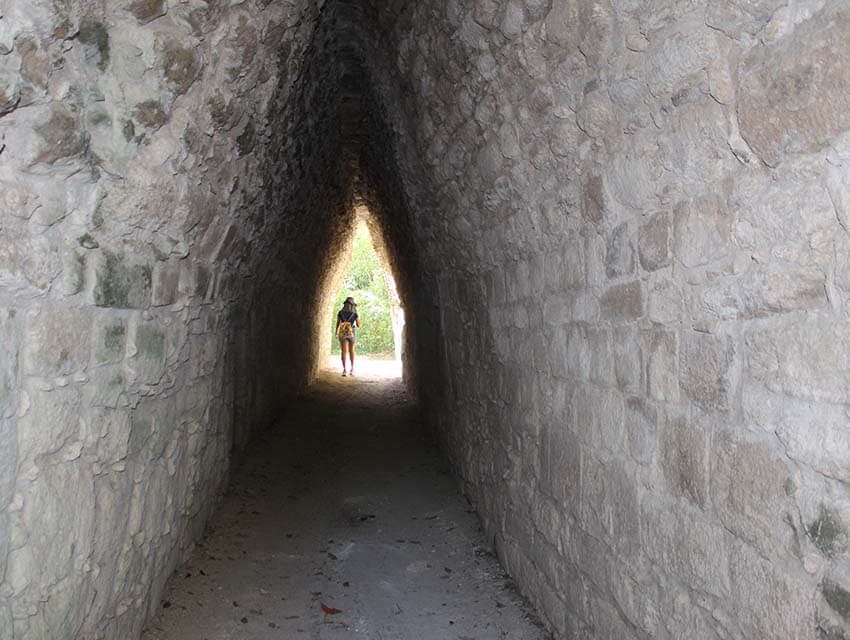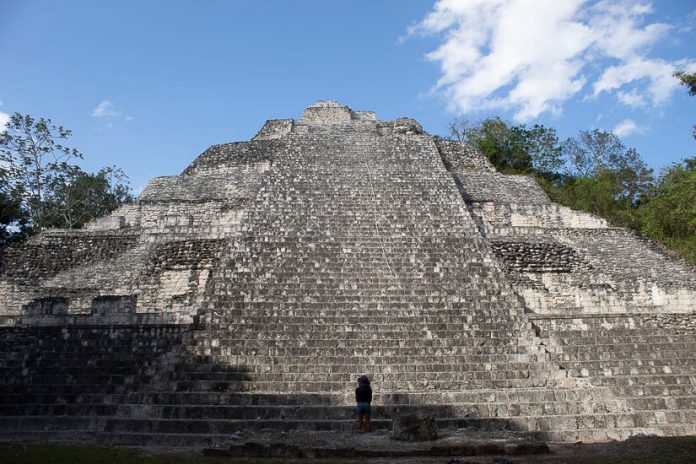If you are a fan of archaeology and history, Becán is yet another beautiful Maya site in Campeche that is a must-see!
Situated around 130 kilometers from Chetumal off Highway 186, you can combine a visit to Becán with a trip to the famous Maya site of Calakmul, and several other nearby ruins.
The National Institute of Anthropology and History (INAH) says the site’s first occupation dates to around 600–300 B.C., and it is believed to have been the capital of the Río Bec region in the late classic period (A.D. 600–900). Becán enjoyed a strategic location and controlled trade routes, according to INAH.
It was eventually abandoned around A.D. 1200–1400.
Becán is Yucatec Mayan for “trench.” It is also translated as “path (cavity) formed by running water” or “path of the serpent,” according to INAH. The name refers to a unique trench shielding its main buildings.

With around a two-kilometer circumference covering an area of approximately 12 hectares, the trench has seven entrances, with bridges to access the enclosed area. The trench had different uses, including possibly for defense. Outside the shielded area, other constructions and residences of Becán’s population have been identified.
There are about 20 structures to see, so expect to spend a few hours exploring the site. Río Bec is one of the key architectural styles to observe here, featuring symbolic twin towers with decorative stairs and temples on top.
Remember to keep an eye out for traces of original paint on buildings.
Once you enter the site, you will see an interesting tunnel-like passage that was once used as a street. In ancient times, there had been a fake arch covering the length of this passage. The arch had included niches for offerings.
An absolute must-see section of the site is the Central Plaza. The magnificent structures here will help you envision the grand city that Becán was.
East of the plaza is Structure VIII, with a beautiful central area and two towers on either side. The main section’s entrance has columns, and a stela — a carved or inscribed stone slab or pillar — stands in the center. The stela probably commemorates a ruler’s official occasion, according to INAH. While some of the building’s rooms are identified as living quarters, there are others believed to have been used for storage or religious ceremonies, including possible self-sacrifices.

North of the Central Plaza is Becán’s tallest building, a large pyramid measuring around 32 meters in height. Named Structure IX, INAH says a burial chamber was found here. The pyramid has a large stairway that leads to a temple on top.
You can climb this pyramid, but the site notice says they will appreciate it if you do not — for preservation and to avoid accidents. You can observe the features of this pyramid from the plaza, however, even without climbing it.
West of the Central Plaza is an interesting building called Structure X that looks like a complex of buildings. It has many rooms across two levels and a temple on the top section. This temple’s facade had decorations representing the Maya creator god Itzamná, also called the Earth Monster, whose remains can be seen.
You can also see the remains of the roof comb — which was once decorated with stucco figures. Structure X has palace complexes that were likely the residences of the city’s key residents, according to INAH.
Towards the south end of Structure X is a magnificent stucco mask with remains of original colors, believed to be of a ruler or a notable person. In the past, this mask was displayed through a glass window, but during our visit, it was covered with a canvas to protect it from the sun. While it is not the same as seeing the real mask, the image on the canvas will help you visualize what it looks like.
Make time to explore the interesting rear of this complex to the west. Next to this complex is the West Plaza. A notable section here is the ball court where the Mayan ballgame believed to represent the recurring life and death cycle was played. It has the usual parallel rectangular platforms, but its playing area is wider than what’s seen on some sites. The ball rings are speculated to have been made of wood, but no traces of them exist.
The East Plaza, which you will see when entering the site, is worth exploring. There are several beautiful buildings surrounding this plaza; a notable one is the magnificent Structure I, identified as one of the oldest buildings on the site.
This structure has many rooms on two levels and two towers on each side measuring around 15 meters in height. INAH says the towers had openings that may have been used for astronomical observations, but they no longer exist.
Check out the round structure called the circular altar in this plaza. These types of constructions are thought to be linked to Kukulcán – the feathered serpent deity.
The palace-like Structure IV in the East Plaza is also worth seeing. Rulers are believed to have occupied certain rooms here. The benches in rooms are considered resting spaces. This building has remains of decorative masks.
There are several other buildings to explore onsite. Don’t forget to also enjoy the natural scenery: near Becán is the town of Xpujil, where you can explore more ruins and enjoy some local food.
Thilini Wijesinhe, a financial professional turned writer and entrepreneur, moved to Mexico in 2019 from Australia. She writes from Mérida, Yucatán. Her website can be found at https://momentsing.com/
